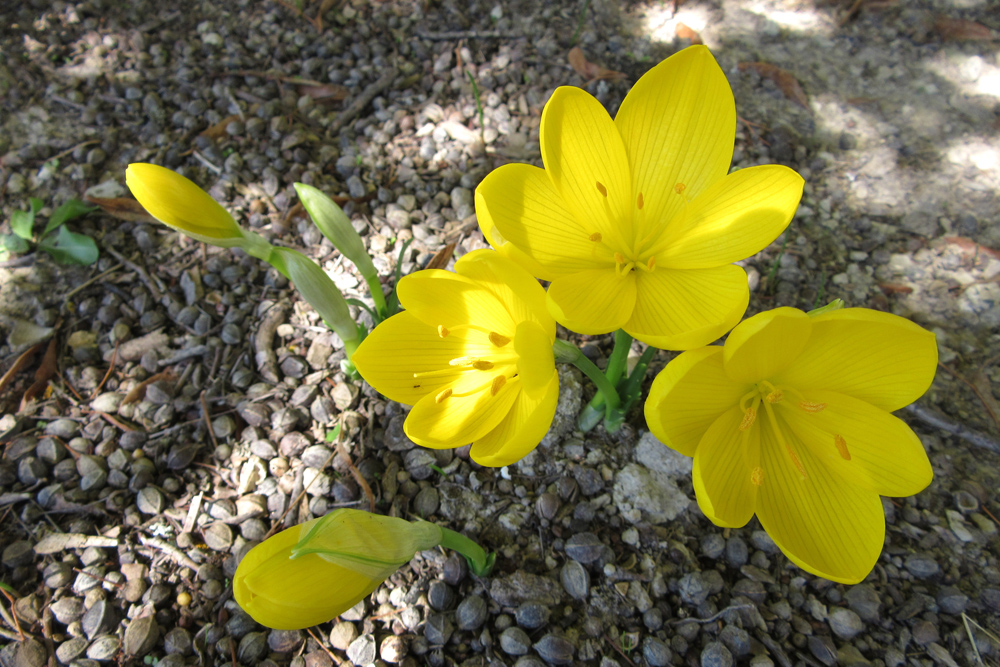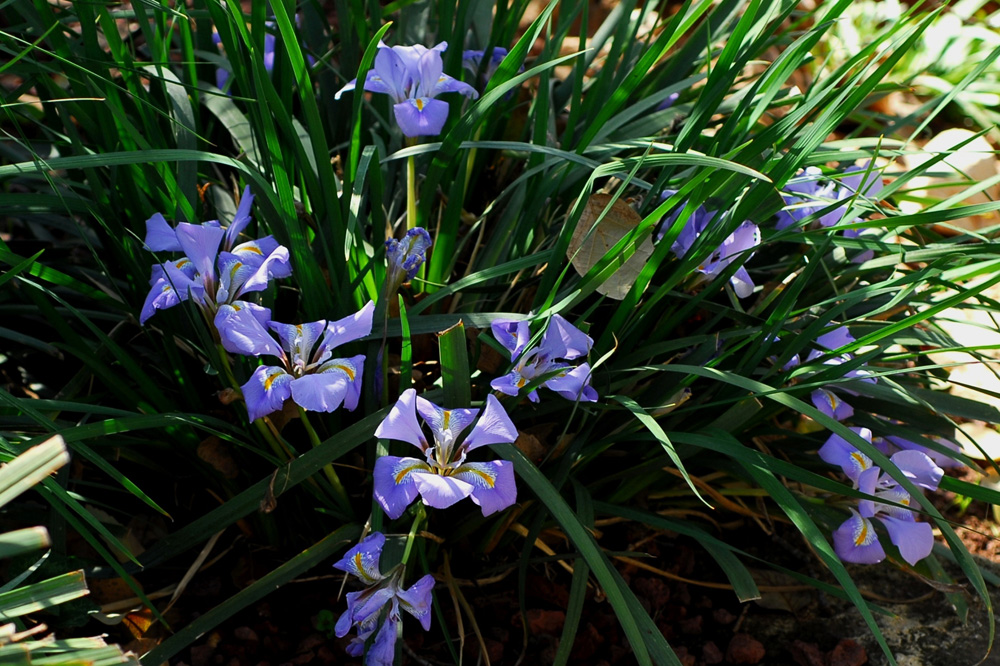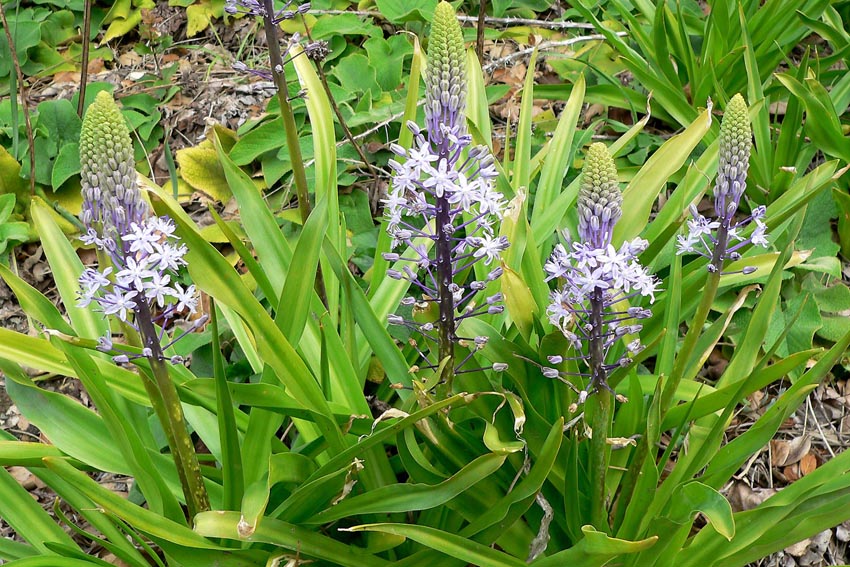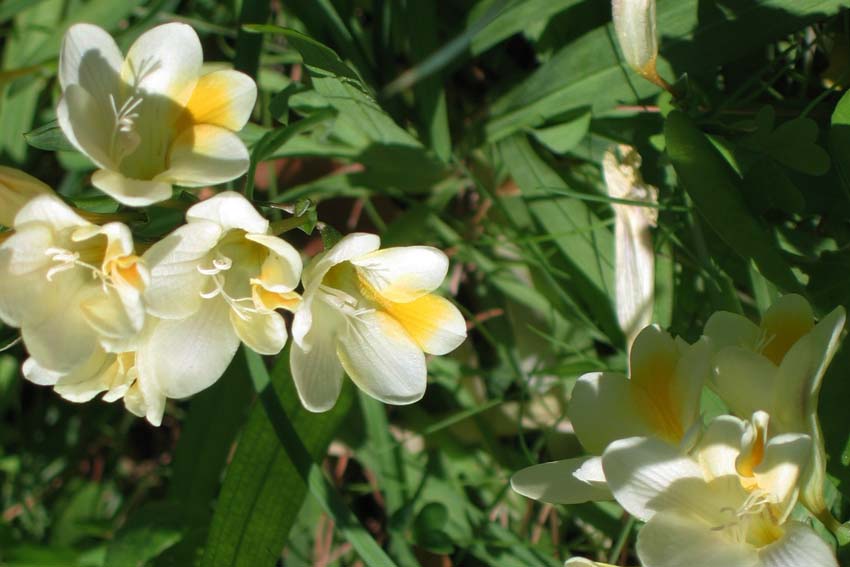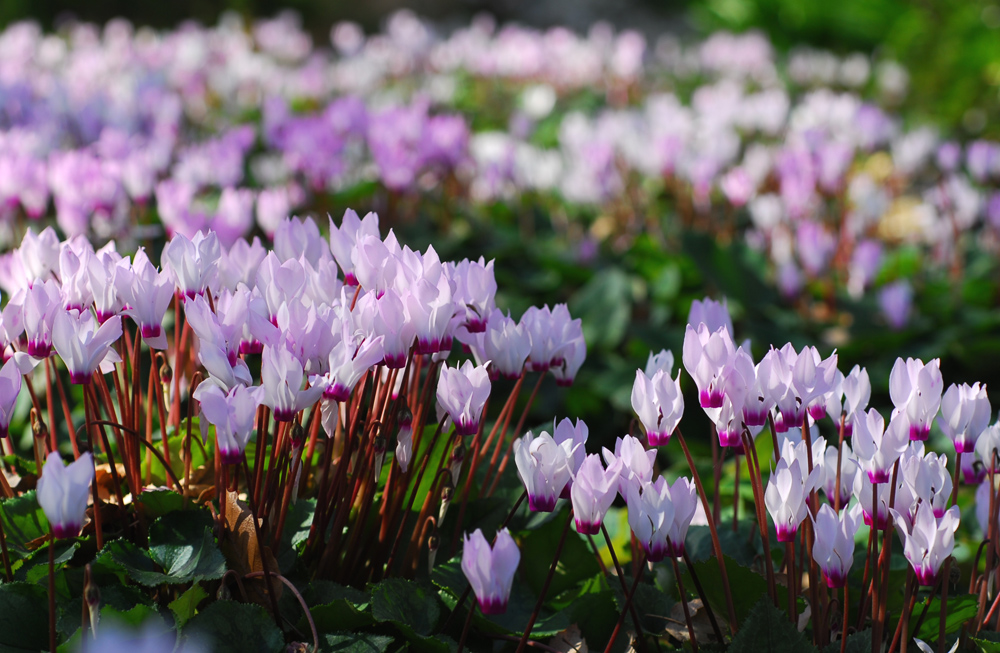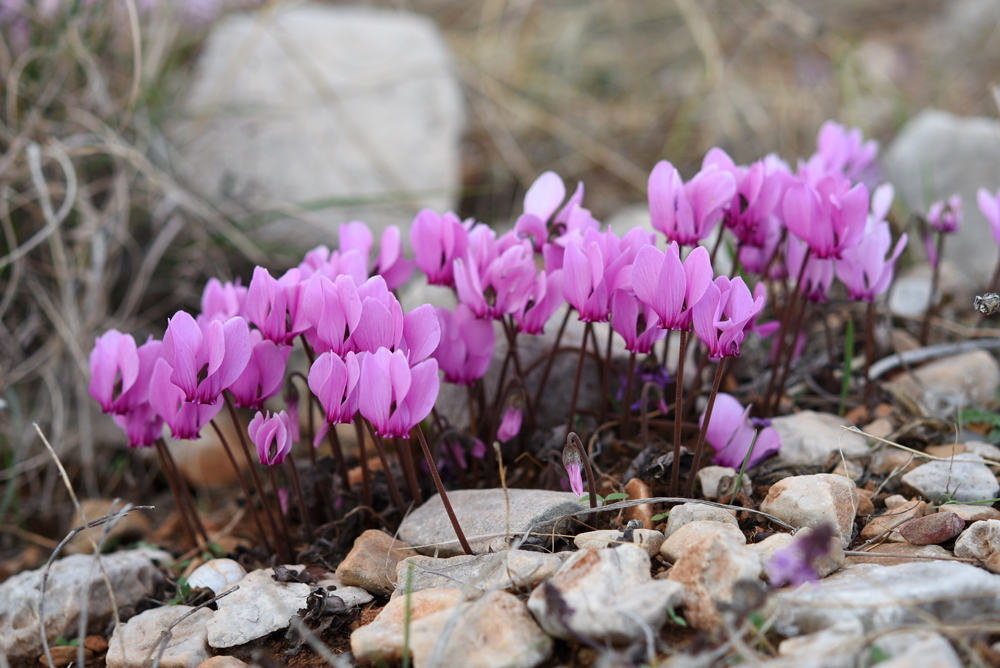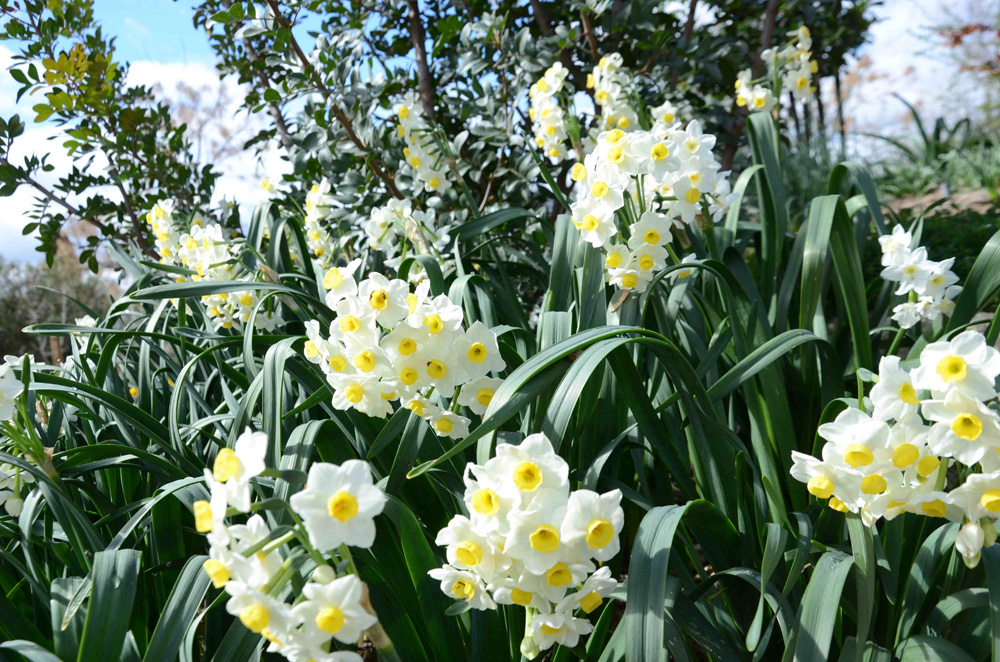Plants / Plantes
Some must-have bulbous plants for Mediterranean gardens
Click on an image to enlarge it / Cliquez sur une image pour l’agrandir
Bulbous plants have had an important role in horticulture since the early centuries. Interest in them grew further when selected species were introduced into cultivation and began to be bred. Some plants became fashionable and highly desired: the tulip mania of the 17th century is the prime example of this, but hyacinths, bearded irises, Narcissus, Lilium and Gladiolus have all also had their moments of being the height of fashion. And fashions in bulbs continue today, with daffodils and tulips giving place to Galanthus (the snowdrop) and Crocus. We collectors can now be divided into galanthophiles and croconuts (I myself belong to the second category).
Bulbs have always been admired for their beauty and scent and in the past were quite easy to obtain, even for ordinary villagers, as they could be collected in many parts of the Mediterranean, North Africa and Central Asia.
The advantage of their period of dormancy was that it made transport easier – a good example is Iris albicans which is native to Saudi Arabia and was introduced to the Mediterranean, Southern Europe and Asia by Muslim pilgrims coming back from Mecca. This iris became particularly popular in Muslim graveyards for its white colour symbolising purity, for the importance of its place of origin and for the fact that no care is needed after the plant has become established. Similarly, Sternbergia lutea was introduced by Greek monks who carried the bulbs from their homeland and planted them in many of the monasteries spread around the Eastern Mediterranean. I cannot stress strongly enough, however, that today bulbs should never be dug up from the wild – indeed, in most countries it is against the law to do so.
Many species need little attention and after being planted in the ground they will thrive and with time form large clumps. Bulbous plants are a good solution for places with difficult conditions, for isolated houses where water is either not available or too precious to be used for irrigation, or for geographic areas characterised by very hot and dry conditions or extremely cold winters. In recent years I have been travelling to Central Asia and was surprised to see how popular these plants are. Early displays of tulips, daffodils, Muscari and Paeonia can be seen outside almost every village house. Some have probably been there for ages, flowering punctually every year after the snow has melted to colour the dull grey surroundings and announce that spring has arrived.
The swapping of bulbs started in early times and continues today. Gardeners are usually generous people who will gladly spare a bulb or two. In this way highly perfumed species such as Polianthes tuberosa (the tuberose), Lilium candidum and freesias are grown in pots or large metal tins at the entrances of houses and on balconies in many villages but are also popular in town gardens and urban balconies.
I particularly remember as a child seeing a small garden in Jerusalem where every spring hundreds of blue Ipheion uniflorum and yellow freesias appeared on both sides of the main path while all around the garden large clumps of the double form Narcissus tazetta ‘Constantinopolitanus’ appeared together with Cyclamen persicum and Sparaxis tricolor. Today bulbous plants are an important feature in the gardens I design, where I use them for various purposes: they are a great addition to an existing garden and often offer a lovely surprise when they flower.
I have made a list of bulbous plants which I recommend for use in our Mediterranean gardens. The criteria for my choice of species is that first of all they need no irrigation, they have a long flowering period, are resistant to diseases, moles etc, they provide a focal point at different seasons and, lastly, they are relatively easy to obtain online from specialist growers, from your local garden centre or nurseries, and of course by swapping with friends and neighbours.
Iris unguicularis
This iris is native to the Mediterranean where it has two subspecies: subsp. cretensis from Crete and subsp. carica growing in the eastern Aegean islands and south-west Turkey. These two subspecies are difficult to grow but there is a form, probably originating in Algeria which has been in cultivation for a very long time. It is occasionally sold under the name Iris stylosa (which is a synonym of I. unguicularis) or Iris algeriensis. This form is characterised by much wider leaves and larger flowers.
It is a tough plant which will grow in difficult conditions.
It can be planted under trees (even pine trees) in shade or in full sun. Its flowering season lasts throughout most of the winter months, often when nothing else is in bloom. New flowers open daily, held on short stems in the centre of the clump. The leaves tend to grow rapidly and I therefore recommend cutting the whole clump to about 10 cm high every three or four years in order to reveal the flowers again. This is also the time for dividing the clump if one wants to plant this iris in other sites. After the first two seasons it will not need any irrigation. It is a long-lived species. There are a few named cultivars, including white forms, but I find these to be weaker plants.
Iris foetidissima
This is another excellent iris species native to southern Europe and North Africa but which has naturalised in many areas. The awful smell denoted by its specific epithet is released only when the tubers and roots are crushed. As well as being a highly decorative plant, this species has the advantage that it can grow in densely shaded parts of the garden where generally very few species could survive.
The flowers are not the best feature of this plant as they are not showy but the dark green sword-like leaves are handsome while the seedpods opening in autumn to reveal the seeds – like shining red pearls – last for quite a few weeks and can be used in flower arrangements. Blackbirds are attracted to the seeds and will spread them. This iris is easily grown from seed and, like Iris unguicularis, is long-lived.
Amaryllis belladonna
Native to the south-west Cape of Africa, this species is increasingly gaining popularity, particularly in the USA. The tall, showy flowers appear in September, symbolising the end of summer. Their usual colour is soft to deep pink but some white and very dark-coloured cultivars are available as well.
Bulbs are easy to obtain but one needs to be patient as they will often not set flowers in the first year. The bulbs should be planted with their necks at ground level. They require locations with full sun or slight shade where the plant will not receive summer irrigation by sprinklers etc. The bulbs of this species do not like to be disturbed. Left to themselves they will form nice clumps after several years. Individual plants will not produce flowering stems each year; thus having several plants will ensure that one has flowers every autumn.
Habranthus robustus
This is another excellent and showy flowering species suitable for growing in pots or in the garden. It starts to flower during summer and into the autumn, the flowers usually appearing in waves at intervals of days and often weeks.
It increases very well, either by new bulbs born next to the mother bulb or by seed. The plant is easily grown from seed and self-sown seedlings will often appear in neighbouring pots. As with Amaryllis belladonna, the bulbs should be planted with their necks at ground level. Species with similar growing habits are Zephyranthes rosea and the much smaller crocus-like Zephyranthes candida. All these species can also be watered in summer.
Ipheion uniflorum (syn. Tristagma uniflorum)
This is a small species with blue star-shaped flowers. It is a super-increaser and will fill a large pot after three to four seasons. It is an excellent plant for dry areas near a path or a rockery where it does not receive any irrigation during the hot season. It flowers in spring for a few weeks and is a very cheerful plant. There are named cultivars such as ‘Wisley Blue’, ‘Charlotte Bishop’ (large pink flowers), ‘Froyle Mill’ (purple flowers), ‘Alberto Castillo’ (white flowers) and others.
Scilla hyacinthoides
A spring-flowering species native to the eastern Mediterranean. Its blue flowering spikes can grow to a metre tall and will last for a couple of weeks. It is also a good increaser which will grow in difficult conditions in any kind of soil. It will bloom in shady areas as well. It is easily grown from seed but it will take four to five years to set flowers.
Freesia refracta, F. leichtlinii and F. alba
These are three similar white-flowering species which have naturalised in various parts of the Mediterranean. They are known for their amazing perfume in spring. Freesia is one of the best bulbs for growing in pots.
Use a medium-sized pot which can be put on the terrace table or indoors to enjoy when the plants are in flower. At the end of the growing season just leave the pot aside in a dry area until the first rains arrive. Freesias will increase rapidly and occasionally seed themselves in other parts of the garden.
Cyclamen persicum and C. graecum
These are two of the easiest and toughest species in this genus. Originating in the eastern and southern Mediterranean, these cyclamens can be enjoyed for their flowers but equally for their beautifully patterned leaves. The two species can live for dozens of years and will seed themselves freely in the garden, often in unexpected places such as holes in a wall or paved area. This is thanks to ants, which collect the seeds and spread them around.
Both species have a long growing season. Cyclamen graecum flowers in autumn without its leaves and produces new leaves after the first rains, while C. persicum will first set leaves and will then bloom for many weeks from January to March. Each mature plant produces hundreds of seeds that will germinate and flower after four years.
Narcissus tazetta ‘Constantinopolitanus’ and ‘Double Roman’
Of the endless cultivars, hybrids and forms of Narcissus these two are centuries-old; their exact origin is unclear but the names indicate that they have been around since Roman and Ottoman times.
These are both probably natural double forms of Narcissus tazetta which have been grown around the Mediterranean for their beauty and their amazing scent. They are strong-growing plants, highly resistant to diseases.
I remember them being sold when I was a child by old Arab and Jewish ladies in the markets of Bethlehem and Jerusalem – where they are still sold today.
The bulbs should be planted 15-20 cm deep and should be lifted when they become too crowded so that the number of flower stems is much reduced. This happens after ten years or so. These narcissi are better planted in full sun so that the flower stems are shorter and less liable to break, particularly after rain when they are wet. When brought indoors, a few stems of flowers will perfume the whole house.
Text and photos 2, 3, 4, 5, 10, 11 and 12: Oron Peri
ORON PERI was born in Jerusalem and now lives in the Galilee region of northern Israel. He is a plantsman, garden designer, botanist and, together with Mansour Yassin, owner of ‘Seeds of Peace’, a bulb nursery with an important collection of bulbous plants from around the Mediterranean. The seed list can be obtained by emailing Oron. Oron’s book, Bulbs of the Eastern Mediterranean, is available from The Alpine Garden Society and you can read a review of it by Trevor Nottle here.
If you would like to know more about bulbs for Mediterranean gardens, listen to the illustrated talk that Oron gave in January 2016 to our sister organisation, Mediterranean Plants & Gardens here.
![]()

